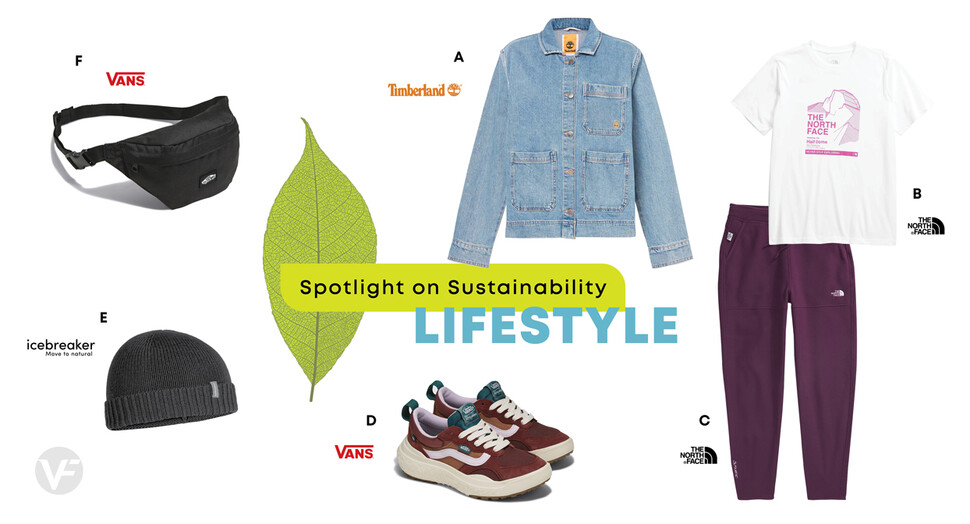Clothes to Up-Level Your Closet While Watching Your Footprint

Lifestyle outfit
- . Made with 31% TENCELÔäó Lyocell fibers produced with REFIBRAÔäó technology which contains a blend of cotton textile waste and wood sourced from responsibly managed forests.
- . Made with 100% Climate Conscious Cotton, grown by U.S. farmers using agricultural practices that help build soil carbon.
- . Thoughtfully designed to be disassembled and recycled by us at the end of its life into raw materials for a second generation of products. Polartec® fleece made with recycled polyester.
- . The Upper is made with a combination of 100% recycled PET and leather. Vans Supports responsible manufacturing via the Leather working group . The midsole, made using at least 50% biobased EVA foam partially derived from plants, is a USDA Certified Biobased Product. All of the rubber used to make this outsole (60% of the compound) is regeneratively grown natural rubber sourced from farms utilizing agricultural practices that are intended to promote biodiversity, enhance water cycles, improve soil health and/or sequester carbon.
- . 100% natural - Ethical and cruelty-free blend of natural fibers that biodegrade and feed the earth.
- . Made with 100% Recycled Polyester Fabric.

Active Outfit:
- . Made with 50% recycled wool fill consisting of ZQ Merino scraps, 100% Recycled Nylon shell.
- . Made with 66% Recycled Polyester Fabric.
- . Made with 86% recycled body fabric.
- . GreenStrideÔäó midsole made using an EVA blend containing at least 65% biobased materials derived from sugar cane and responsibly grown rubber. The midsole is USDA BioPreferred Certified. 55% of the rubber used to make the outsole is sourced from farms using regenerative agricultural practices. This method of farming incorporates a variety of plants to mimic a natural forest and can help the land to absorb carbon, retain water, restore biodiversity, and help generate additional income streams for farmers and their communities. Upper made with a combination of waterproof Premium Timberland┬« leather and ReBOTLÔäó fabric containing at least 50% recycled plastic.
- . Made with circular yarn from a 50-50 blend of sock waste and responsibly sourced Merino wool.
- . Made with recycled nylon with non-PFC durable water-repellent (non-PFC DWR) finish and 600D recycled polyester with non-PFC DWR finish.
- . Made with 52% Recycled Nylon.
Interested in making more sustainabilityÔÇôfocused fashion choices, but not sure where to start?
Maybe you already buy organic food and recycle. You remember your reusable grocery bags and you might even compost. But when it comes to your closet, youÔÇÖre lost. How do you find pieces that are fashionable, functional and help you be a more conscious consumer?
┤¾¤¾┤½├¢ Corporation and our portfolio of brands are here to help. WeÔÇÖre committed to environmental sustainability and we have you covered if youÔÇÖre seeking fashion pieces with sustainable attributes.
WeÔÇÖve picked out some of our favorite products that incorporate sustainable materials from across our brands and curated this guide to help you understand what makes these products unique. At ┤¾¤¾┤½├¢, our Sustainable Materials Vision helps guide our use of sustainable materials. For example, by choosing raw materials that are grown or produced using approaches that help to reduce carbon emissions, we can work towards meaningfully decreasing our greenhouse gas (GHG) footprint.
What are some ┤¾¤¾┤½├¢ products that incorporate sustainable materials?
Above are two outfits ÔÇô a womenÔÇÖs lifestyle outfit and a menÔÇÖs active outfit ÔÇô where every item incorporates materials that have sustainable attributes. These items can be mixed and matched to create a variety of looks to meet your needs whether youÔÇÖre exploring city streets or hidden trails. And this is just a small sampling of the items you can find from ┤¾¤¾┤½├¢ brands that incorporate sustainable materials or were designed using circular design principles.
How does ┤¾¤¾┤½├¢ approach sustainability in fashion?
At ┤¾¤¾┤½├¢, we are committed to reducing our greenhouse gas (GHG) footprint. What does that mean in practice? When we looked at our emissions footprint, we learned that over 70% of our emissions originate from the extraction, processing, and production of the raw materials that make up our products. While we are still advancing the use of renewable energy in our direct operations and supply chain, working to minimize waste and plastic packaging, and lowering emissions related to shipping and distribution, much of our efforts are focused around using sustainable materials and driving circular initiatives.
What does ┤¾¤¾┤½├¢ mean by ÔÇ£sustainable materialsÔÇØ?
As we mentioned, to guide this work, ┤¾¤¾┤½├¢ has developed a Sustainable Materials Vision, which details our aspiration that our top materials shall originate from regenerative, responsibly sourced renewable and/or recycled sources. You can read more about these types of materials on our website or in our latest Environmental and . By choosing raw materials that are grown or produced using approaches that help to reduce carbon emissions we can work toward meaningfully decreasing our GHG footprint.
LetÔÇÖs take regenerative agriculture as an example. Regenerative agriculture encompasses a variety of environmentally and socially conscious practices, which aim to help support biodiversity, enhance water cycles, improve soil health and sequester carbon. This means that when we use cotton, leather, rubber or wool that is grown using regenerative practices, we are supporting a more holistic approach to land management that works with natural systems and processes in an effort to restore healthy ecosystem function. The science is quickly evolving and the potential for impactful change is promising, which is why advancing regenerative agriculture is a focus of our sustainability strategy.
┤¾¤¾┤½├¢ also tries to incorporate recycled materials whenever possible. Nylon and polyester are important materials in many of our products ÔÇô and when they come from recycled sources, industry data shows us that the environmental impact on the planet can be reduced. When we can take these recycled fabrics back into new garments, it helps our cause by finding a productive stream for waste. Which brings us to circularity.
Circularity
Embedding circularity in our product design and consumer engagement efforts is becoming increasingly important to how we approach our business. We design products utilizing circular design principles including durability, recyclability and disassembly. We strive to create products that use resources conscientiously, can be used for an extended period and reintroduced in some form to the supply chain or to the consumer at the end of their originally intended life.
Innovation in sustainability is happening quickly, and our teams are learning more about new materials, ways to design for circularity, and strategies to help lower our impact every day. We are lucky to have amazing partners helping us ÔÇô and consumers who support this work and care about where we source our products.
As a consumer, how do you know what products are made with sustainable materials or practices?
You can find a lot of this information by reading the hang tag or looking online for specific keywords. When youÔÇÖre looking at an itemÔÇÖs description or features online, some may be denoted as ÔÇ£circularÔÇØ which means they are designed with circularity in mind - using fewer materials that are easier to take apart or recycle. Others may say ÔÇ£recycled polyesterÔÇØ or ÔÇ£recycled woolÔÇØ or ÔÇ£made with U.S. cotton from farmers using agricultural practices that help build soil carbonÔÇØ ÔÇô the last of which means the cotton is grown using regenerative practices.
It may be confusing at first, but the more you look at labels, the easier it will be to spot when a product incorporates sustainable materials. Every little bit makes a difference.









